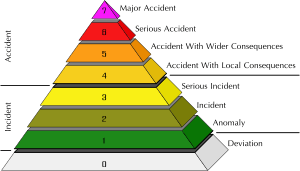International Nuclear Event Scale facts for kids
The International Nuclear Event Scale (INES) is a system. It helps people understand how serious a nuclear accident or incident is. The International Atomic Energy Agency (IAEA) created it. This system helps everyone react quickly to protect themselves. Each level has specific rules to decide how serious an event is.
The INES scale has 7 levels, plus a Level 0.
- Levels 1 to 3 are called "incidents." These are less serious events.
- Levels 4 to 7 are called "accidents." These are more serious events.
- Level 0 means there is no safety problem.
Contents
Understanding the INES Levels
The INES scale helps experts communicate about nuclear events. Here is what each level means:
Level 7: Major Accident
This is the highest level. Accidents at this level cause a lot of pollution and radiation outside the nuclear site. The health of many people can be in danger. There are also big effects on the environment.
- Examples: The Fukushima nuclear disaster in Japan (2011) and the Chernobyl disaster in the former Soviet Union (1986).
Level 6: Serious Accident
These accidents also cause a lot of pollution and radiation outside the site. Several governments might need to take many steps to protect their people.
- Example: The Kyshtym disaster at Mayak in the former Soviet Union (1957).
Level 5: Accident with Off-Site Risk
These accidents release some radiation. Some groups of people who are at risk might need special protection.
- Examples: The Windscale fire in the United Kingdom (1957) and the Three Mile Island accident in the United States (1979).
Levels 5, 6, and 7 usually mean there is serious damage to the nuclear reactor's core or its safety barriers.
Level 4: Accident Without Off-Site Risk
This level means there is important damage to the reactor's core or safety barriers. It might also mean a worker (or more) has been exposed to dangerous radiation. However, the impact outside the site is small. Public exposure to radiation is within safe limits.
- Examples: Events at Windscale in the United Kingdom (1973), Saint-Laurent in France (1980), and Buenos Aires in Argentina (1983).
Level 3: Serious Incident
This level means there is very little impact outside the site. But there might be a serious spread of contamination on the site itself. Or, a worker (or more) might have serious health effects from radiation. It is like a "near accident" where almost all safety systems have failed.
- Examples: Events at Vandellos in Spain (1989) and the THORP plant at Sellafield in the United Kingdom (2005).
Level 2: Incident
This is an incident with no impact outside the nuclear site. It means there is a significant spread of contamination on the site. Or, a worker might have been overexposed to radiation.
Level 1: Anomaly
This is an event that goes beyond the normal way the nuclear facility is allowed to operate. It is a small problem.
Level 0: Deviation, No Safety Relevance
This is a "below-scale event." It means there is no safety problem at all.
Some events are called "out of scale." This means they have no safety importance.
See also
 In Spanish: Escala Internacional de Sucesos Nucleares para niños
In Spanish: Escala Internacional de Sucesos Nucleares para niños


